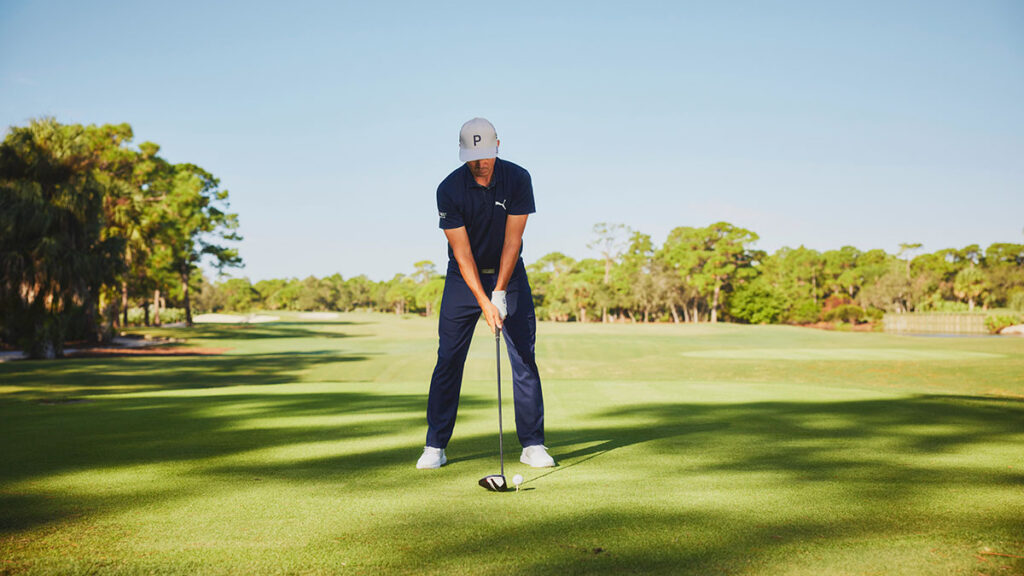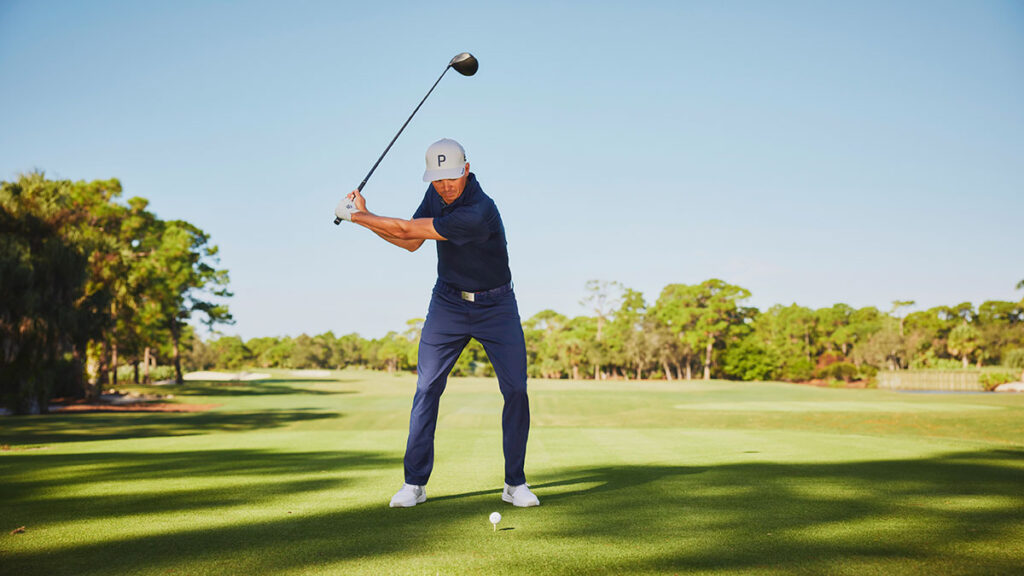How Butch helped me find my swing again, and the lessons you can learn
Photographs by Sam Kweskin
The standard advice when things aren’t going your way is to keep looking forward, but for me, I had to look back. Back to my old coach, Butch Harmon, and back to the things that worked when I was playing my best. Once I figured that out, everything started to click.
When Butch stopped travelling on tour in 2019, I asked another teacher, John Tillery, to help me. John showed me things in a new way. But every player has their journey and mine led me back to Butch – just not how you might expect.
For the better part of three years, I was fighting my swing, and I would wear out the range at the Medalist, my home club in Florida. I always seemed to run into one member there, Butch’s brother Craig, who’d recently retired as the longtime pro at Oak Hill in New York. One day in September 2022, I saw Craig on the range and got an idea, so I called Butch.
What if we started working together again, but this time, Craig could be his eyes? Butch and I could send swing videos back and forth, and Craig could keep me on track when I practised. Butch loved it, and that’s how we reunited. Butch saw right away that I had slipped into some old habits, so the fixes he mapped out were things we’d worked on years ago.
The results came fast. I went from missing five of eight majors in 2021-2022 to finishing top-10 twice in the first month with Butch. Then, I got a win last year and made the Ryder Cup team. I’ll show you what we did, but my big message is this: what worked once will probably work again.

Setting up more connected
One thing about the golf swing – it’s a chain reaction. It’s not so much isolated positions, but what you did to cause those positions to happen. My takeaway was getting off-track (hands going inside, clubhead staying outside), but we could correct some of that in my setup.
We focused on setting my shoulders square, parallel to my target line, not to the right, which was my tendency. I also like to feel the upper part of my right arm pressed against my rib cage [above]. Butch calls this “screwing in the right elbow”. That connection helps the arms and body start back together and keeps my hands from getting inside too fast.

Getting off to a better start
Most of the changes we made were to my backswing, and it started right off the ball. As I said, I had a tendency to pull my hands in and leave the clubhead out. You can see in this photo [below] that the clubhead is just inside my hands, which is where I want it. In my old swing, the clubhead would have been well outside my hands. That’s always been a problem for me and requires re-routing the backswing to set the club in a good position at the top. Nothing beats starting the club on line and letting the swing flow from there.
Knowing that, we worked on getting my hands and the club tracking to the inside in sync. A good image for me is that the clubhead moves first, getting a little headstart before the handle moves – after all, the clubhead has further to go. It’s also important that my upper body is beginning to turn at the same time so that I feel some pinch pressure in my right armpit, which keeps my arm swing and body turn connected. A lot of times I rehearse my takeaway before I swing, making sure my hands and the clubhead are lined up.
Butch says copy this: “Rickie was getting out of position right away, which put him on a recovery mission. A good checkpoint for any golfer is when the shaft gets parallel to the ground. Make it line up with your stance line, which means the club is starting on the correct plane. Some golfers practise with a club across their toes and match up the shaft they’re swinging to the one on the ground. I prefer to lay the club across the heels, because some golfers flare one or both feet. Getting started right can’t be overstated.”

Swinging more upright going back
Now we’re getting to the crux of the changes, so Butch often steps in and puts me in the right position. In my old swing, my left arm was very flat at halfway back. I had to literally flip the club over to continue the backswing. To avoid having to do that, I needed to get into a more vertical position with my left arm, as Butch is helping me feel here [above]. A good image I developed is my left arm sliding up my chest as opposed to stretching across it. To me, it feels more up and down.
Of course, it’s a matter of degrees, so be careful not to simply lift the club to the top – a common fault I see in amateur swings. I needed to exaggerate the vertical feel; you might need to do the opposite.
I’m still moving the club to the inside, which comes from keeping my upper body turning. There’s
multiple moves happening at the same time. In short, my body turns back while my arms swing up.

Reaching the top on plane
Butch is hands-on again here because this is where I need to set the club at the top so that I can just swing down and let it go. I don’t want to have to manipulate the club on the downswing. As Butch says, the function of the backswing is to set up the downswing to where you can easily get back to the ball. If I nail this set position, I don’t have to steer the club coming down. It feels like a direct path.
Even though we got my left arm more vertical halfway back, I was still a little laid off at the top, meaning the club was too far behind me and pointing left of my target. To set the club more on plane, I need a little more hip turn. When Butch nudges my right hip back, the club slots in the perfect position – pointing directly at the target [above]. When no one is around to eyeball what I’m doing and make sure I don’t revert to my flatter backswing, I use an old swing thought Butch got from Greg Norman back in the day: Greg used to think, R.P.B. or Right pocket back. When I turn my right hip deeper, my backswing is spot-on.
Butch says copy this: “Unless you have exceptional mobility, the popular idea to restrict your hips on the backswing to create resistance as you turn your shoulders is bogus. Most players, Rickie included, need to turn their hips fully to complete the backswing. For less-flexible players, I even recommend a closed stance (drop the right foot back) to give the trail hip a head start. So go ahead and turn your hips as much as possible. You’ll make a bigger move behind the ball and have more to hit with on the downswing.”

Keeping the transition smooth
With my backswing in a better place, we needed to confirm the changes by seeing improvements in my downswing (remember the chain-reaction concept). The first step was making sure my arms and body were staying connected at the top. When my body stops turning, I don’t want my arms to run on at all. They should stop swinging at the same time. When I focus on this, my backswing can feel shorter, so I have to guard against getting quick at the change of direction, trying to subconsciously make up for a shorter swing.
Butch likes me to make some stop-and-go swings when we practise. Swing to the top and stop, then swing down and through. I even hit balls this way. It really helps me feel that connected backswing position, then I can transfer my weight to my front side and let the club drop before turning on the speed [below]. When my transition from backswing to downswing is smooth, I always hit better shots.
Butch says copy this: “If you don’t have the range of motion to make a full backswing, you probably rush the club down from the top. That tends to be all arms and upper body. Instead, focus on starting the downswing from the ground up, with the club whipping through last. No matter how short your backswing, that sequence works best. As Rickie says, stop-and-go swings are great training, and I like full swings in slow motion to really feel that good, ground-up sequence coming down.”

Staying down longer
As I said, I just want to be an athlete and fire through the ball, but we do keep an eye on one thing through impact – my posture. Sometimes I stand up and out of my forward bend too soon. That raises the handle of the club and usually leads to a right miss. My simple thought – another Butch favourite – is to cover the ball through impact. In other words, keep my chest pointing down as I extend my arms out towards the target [above].
One more thing about Butch: my time with him always has been so fulfilling. He’s helped my technique, of course, but half of what he does for me is self-belief. There’s nothing like having someone on your side who helps you see that the work is worth it and you can get where you want to go. I really believe my best golf is ahead of me.



